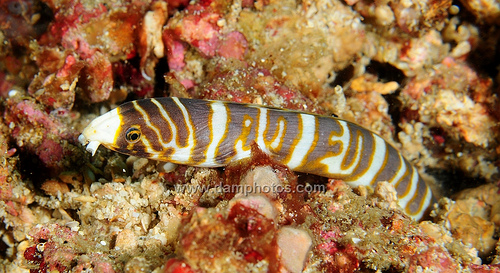There are only eleven known species of snake eel in the world —and one of them is named after the Filipino diver who helped scientists identify it.
The new species of snake eel, commonly known as Peri's Snake Eel (Myrichthys paleracio), was named after Christopher “Peri” Paleracio, dive guide at a diving resort in Anilao, Batangas. Paleracio (the person, not the fish), collected the species and submitted it for examination at the California Academy of Sciences (CAS) in 2009.
Photo credit: Mark Atwell
The snake eel M. paleracio was first seen in the shallow-water coral reefs of Verde Passage, located between Batangas and Oriental Mindoro.
“Having a snake eel named after me is something. I feel really lucky than honored actually,” said Paleracio.
Peri’s snake eel
According to the International Journal of Ichthyology, published in California, USA, M. paleracio differs from all known Myrichthys in its vivid brown and white coloration; its body elongation; and the number of vertebrae in each segment of its spinal column.
“I’ve been seeing that particular kind of eel for years. I thought that it was just a color variation of the other snake eel that was already identified,” Paleracio said.
Based on studies, M. paleracio is most closely related to the dark-spotted and banded Indo-Pacific species M. maculosu and M. colubrinus, both also occur in shallow water within the Philippines Archipelago. However, none were observed at the locations where M. paleracio was captured.
Internationally-renowned marine scientist Dr. John E. McCosker and Dr. Gerald R. Allen, an expert on the classification and ecology of coral reef fishes in the Indo-Pacific region, received the specimen from Paleracio.
McCosker is a senior scientist and the current chairperson of the Aquatic Biology Department of CAS in the state of California, USA. Allen of Perth, Australia, on the other hand, served as the Western Australian Museum’s Curator of Fishes for 25 years and is now working as a full-time consultant of Conservation International, an organization dedicated to protect the Earth’s richest regions of plant and animal diversity.
Catching and naming the eel
In 2009, when Allen and Roger Steene, also a known Australian underwater explorer and photographer, went for a dive with Paleracio, they realized that the particular snake eel has not yet been identified.
The fish experts decided that the snake eel should be caught for identification.
Paleracio recalled, “I tried catching it with the net that we are using to other fish but this one is not that easy. It is very slippery, and can escape from your grip easily.”
In an effort to catch the snake eel alive, Paleracio had to struggle staying underwater with barely enough air to breathe.
“It was a struggle for me to get it alive. When I caught it, I barely had enough air in my tank to reach the surface,” he said.
In 2011, the California Academy of Sciences arranged its biggest expedition, composed mainly of marine biologists and other fish experts, in the Philippines to find and get the eel. McCosker interviewed Paleracio for the needed data in their study.
McCosker and Allen decided to name the species in honor of Paleracio, as the person who collected the specimen.
Fish and sea slugs guru
Every year, Paleracio also contributes an average of five unidentified species of nudibranch (a form of sea slug). The Philippines has been tagged as the “Center of the Center of Marine Biodiversity” by scientists since 2005, making the country a magnet for marine biodiversity explorers.
Dr. Terry Gosliner, also from CAS, called Paleracio “the best dive guide in the Indo-Pacific” in his book “Indo-Pacific Nudibranchs and Sea Slugs,” published in 2008.
Paleracio is also an avid naturalist and photographer.

